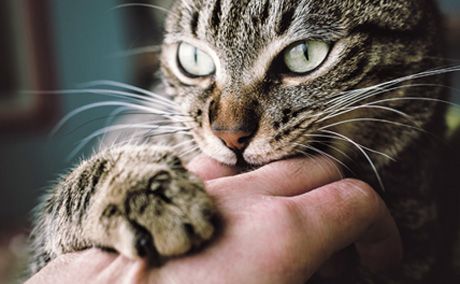Stranger danger: Managing stranger-directed aggression in cats
ELise Christensen, DVM, DACVB, offers solutions to help clients and keep cats in the home.

Getty Images
In today's society, cats experience little variability in their environment. They live at home and their day-to-day routine is largely the same, so they end up sleeping a lot-sometimes this could be out of a lack of enrichment. So when change happens-a guest visiting or a new cat added to the household-their sense of equilibrium is thrown out of balance. This can lead to aggression, says E'Lise Christensen in her lecture “Get Lost! Stranger-directed aggression in cats,” which she gave at the CVC in Kansas City.
Stranger-directed aggression is typically fear-driven, territorial, petting-induced and/or play-related. If the cat is really fearful, aggression may be redirected to either the owner or other pets in the home. But, improvement is very likely, even with minimal work, Christensen says.
Enrich their space!
There are easy and relatively inexpensive ways to give cats environmental enrichment. Christensen recommends:
> Puzzle feeders
> Very small bowls of food or puzzle toys in many rooms throughout the home to encourage “hunting” behavior
> Neko flies cat toys
> Hexbugs (small battery-operated toys that are technically for children but mimic the movement of bugs-cats love them)
> Laser pointers-though the use of lasers can agitate and frustrate some cats so use caution. At this point, anecdotal evidence suggests laser pointers should not be used around dogs, Christensen says.
Warning signs
When the following behaviors begin to present, aggressive behavior may not be far behind:
> Fearful behavior
> Tail thrashing
> Excessive facial bunting
> Redirection of defensive behavior toward the owner
> Urinating or defecating out of the box
These behaviors can occur multiple times, either daily or weekly, or the cat may hide all the time, except when it comes out to be aggressive, Christensen says.
Examples of aggressive behaviors:
> Hissing, swatting, hiding, growling or biting
> Injuries
Where to start
When patients are presented with stranger-directed aggression the first place to start is to rule out a medical component to the cause of the behavior. A complete physical examination, CBC, chemistry, urinalysis, and a thyroid assessment provide important baseline data. Other diagnostics depending on clinical signs might include toxoplasmosis titers, empirical pain management trials, blood pressure assessment, and historical evaluation for a cognitive disorder, Christensen says.
During your examination take a through history from the client. Things to ask?
> What is the duration and development of the behavior?
> Have injuries occurred?
> Who are the targets of the aggression and what is the predictability of the behavior?
> How is the living space laid out?
> If there are multiple pets in the home, how do the pets interact?
> What is the human family system like?
Next steps
The next thing to do is to assess the patient and discuss safety. Create structure and a plan to decrease exposure to problem stimuli in the home.
Identify triggers for the cat and its threshold for fear and/or aggression (aka the cat's personal safety bubble), and then avoid them, Christensen says. Create a safe space for the pet, like a separate room, a crate or cat condo, with the goal of decreasing behavioral arousal, because once aroused, cats stay in that state for hours or even days. For example, Christensen says, cats can be taught to go to a spot like you can with dogs. Give them a “base” where they feel safe, and give them lots of positive reinforcement when they use that base.
Talk to the clients and teach them how to add environmental enrichment and behavioral modification training for their pet. This plan can be done with or without medication recommendations or ancillary therapies like pheromone diffusers in the home.
Whatever the plan, it's important that clients don't use punishment when the aggressive behaviors occur, Christensen says. Punishment can increase aggression, decrease learning and the threshold for aggression, cause injury to the owner, and increase fear and anxiety.
It doesn't end there
The more clients get used to their cats' aggression, the less proactive they are and the more reactive they are to the behavior. So when things get better, Christensen says, many pet owners are happy and become lax with the behavioral management plan that you've created. Plan for a follow-up visit to reinforce the treatment.
Treatment will only work if the environment in the home is conducive to the treatment plan working.